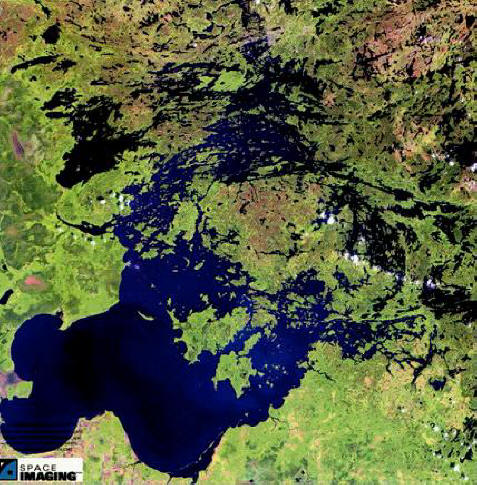|
|
Lake of the Woods
Dec
24, 2008
Located
on the border between Canada and the
United States, this formation
appears to indicate electric
scarring.
As has been reported in several
previous Picture of the Day
articles, the Earth has apparently
been the scene of intense
bombardment from space. According to
the prevailing geological opinion,
scars found on every continent and
under the waters of every ocean are
the result of big rocks impacting
the surface and mechanically
blasting out the material, leaving
craters behind.
The Electric Universe hypothesis
offers another perspective on the
observations. Several factors come
into play that are not available to
the consensus theories of geophysics
because the lexicon of descriptions
available to them does not include
electric arcs or traveling
subterranean electric discharges.
There are, of course, many possible
explanations for craters, canyons,
escarpments, mountains and ocean
basins, but once the electric force
is included in the search for those
explanations an entirely new way of
seeing the world becomes possible.
In this realm, that of deep
background and the origination of
basic theoretical foundations, the
viewpoint expressed in these pages
must be considered diametrically
opposed to the gradualism that
dominates science today.
Rather than basing opinions on the
slow, steady, familiar processes of
erosion—temperature changes, rain,
windblown sand, ice and snow—the
proponents of Electric Universe
theory are attempting to reclassify
geophysical processes as rapid,
catastrophic, and world-changing. In
many cases, the almost unimaginable
must be acknowledged: gigantic
formations like the Grand Canyon or
Manicouagan Crater were created
in a time period that encompasses
the historical memory of humankind.
This new paradigm means that words
like "crater," for example, must be
stripped of all previous assumptions
that are stimulated by it. One
almost immediately thinks,
"volcano," or "meteor," when the
word is used.
As previously stated, catastrophism
should be part of a new way to see
the world, and volcanoes or meteor
strikes are indeed catastrophic, but
geological theory consigns them to
the "rare" or "infrequent" category.
When was the last time a volcano
blew-out a
100-kilometer-wide crater, for
instance?
Considering the presumption of an
electric discharge, a better
description might be "circular
formation" rather than "crater," and
Lake of the Woods certainly displays
those features that have been
described elsewhere as electrical.
Concentric rings and radial
force patterns are immediately
evident, as well as the scalloped
edges of the southwestern shoreline.
A primordial characteristic of
electric arcs is that
they spin. They are composed of
multiple independent plasma current
filaments in a collimated beam. The
independent filaments are attracted
to one another in a linear
relationship, but are prevented from
coalescing because of electrostatic
repulsion, which also causes the
filaments to form twisted-pairs, or
Birkeland currents. Electrical
engineers use twisted-pairs of wires
because it is the most efficient
means of transferring electrical
energy with least loss.
A spinning electric arc will machine
down through the strata like an
auger of fire. In the picture at the
top of the page, the spin pattern is
preserved in the southern edge of
the lake. The
three-lobed bays that twist in a
northerly direction are intriguing,
as are the many islands that follow
multiple chords like outwardly
expanding waves across a wide area.
Lake of the Woods is 110
kilometers long and up to 95
kilometers wide. It has an area of
approximately 4472 square kilometers
and more than 14,000 islands, so it
is by no means small. Due to its
location, it could be considered
among one of the lesser cousins to
the Great Lakes and could have been
formed alongside them in a single
cataclysmic event.
In an upcoming Picture of the Day,
the Great Lakes and the Saint
Lawrence Seaway will be analyzed for
their origin in the paradoxical
fires of creation and destruction
that the thunderbolts of the gods
present. In general, the lake basins
around the world should be
reconsidered and not too readily
consigned to faith in 200-year-old
theories.
Written by Stephen Smith from an idea
submitted by Brad Bensen
|
|
|
|
|
|
SPECIAL NOTE - **New Volumes Available:
We are pleased to announce a new
e-book series
THE UNIVERSE ELECTRIC. Available now, the first volume
of this series, titled Big Bang, summarizes the failure of modern cosmology
and offers a new electrical perspective on the cosmos. At
over 200 pages, and
designed for broadest public appeal, it combines spectacular
full-color graphics with lean and readily understandable
text.
**Then second and third volumes in the series are now available,
respectively titled Sun and Comet, they offer
the reader easy to understand explanations of how and why these bodies
exist within an Electric Universe.
High school and college students--and teachers in
numerous fields--will love these books. So will a large
audience of general readers.
Visitors to the Thunderbolts.info site have often
wondered whether they could fully appreciate the Electric
Universe without further formal education. The answer is
given by these exquisitely designed books. Readers from
virtually all backgrounds and education levels will find them
easy to comprehend, from start to finish.
For the Thunderbolts Project, this series is a milestone.
Please see for yourself by checking out the new
Thunderbolts Project website, our leading edge in
reaching new markets globally.
Please visit our
Forum
|
|
|
|
|
|
|
|







